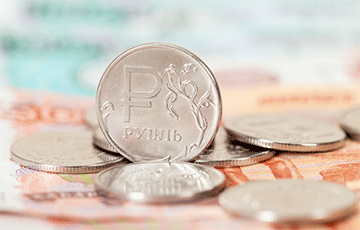"Russian Mountains": What's Happening To Belarusian And Russian Ruble?
30- 25.05.2022, 7:49
- 37,334

Lukashenka's nervous laughter at his meeting with Putin was for a reason.
"The ruble is strengthening at a furious rate," it is hard to argue with these words of Aliaksandr Lukashenka at his meeting with Vladimir Putin right now. The jump in the exchange rate is all the more surprising if one considers the massive international sanctions imposed on Russia. But this "miracle" has a flip side, writes Salidarnasts.
On February 23, 80 rubles were given for 1 U.S. dollar. Immediately after the outbreak of the war there was a collapse of the Russian currency: up to 120 rubles per dollar.
But then there was a U-turn. At the time of publication of this article, the official exchange rate in the Russian Federation was under 57 roubles! That is, much less than even before the "special operation".
The Belarusian rouble, although oriented on the basket of currencies, is most dependent on the Russian one. That is why our currency in many respects repeats the trajectory of the Russian currency: on February, 23, the dollar was worth 2.64 roubles, on March 16 - 3.32, and on May 24 - 2.46.
The reasons for such a "zig-zag" are as follows
1. Shortly after the outbreak of the war, Russia imposed limitations on the purchase of currency.
2. At the same time imports collapsed there.
3. ... and exports rose - due to a jump in prices, especially energy prices.
As a consequence, demand for dollars and euros fell sharply and supply rose. In such circumstances, the Russian ruble (and the Belarusian ruble with it) began to appreciate at an unprecedented rate.
Why is it bothering Lukashenka?
"We'd better not go too far here!" added the Belarusian ruler about the ruble strengthening. One would ask, what's wrong if the dollar keeps getting cheaper?
In fact, it creates problems. The Russian government benefits from a moderately weaker rouble: after all, the budget gets most of its income in dollars and euros and spends it in roubles. The result is now creating a considerable budget deficit. The same, though to a lesser extent, applies to Belarus.
What will happen next?
Therefore a U-turn is expected in the foreseeable future. Experts reckon that by the end of the year the official rate of the Russian Central Bank will be around 75-80 Russian rubles per dollar. The Belarusian currency will also fall in price.
These forecasts, however, do not take into account the "political surprises" the Kremlin is so good at. Therefore, the rate of 100 or 150 Russian roubles per dollar is possible.
The current exchange rate, by the way, is fairly relative. Back in April, Aleksei Kudrin, chairman of the Russian Accounts Chamber, admitted that "the Russian ruble is no longer a freely convertible currency".
The Bell notes: "For individuals, the dollar exchange rate remains largely virtual. Due to Central Bank restrictions, all currency purchased after March 9 on the exchange or in bank applications can only be cashed in rubles. The only way to get hard currency in cash is to exchange rubles at the bank, but in this case the exchange rate will be far from the one on the stock exchange: for instance, on May 19 the dollar was sold at 78.49 rubles at Sberbank - 16 rubles more than at the stock exchange".
In general, after the peak, the Russian ruble will sooner or later fall. The Belarusian currency will also weaken.









